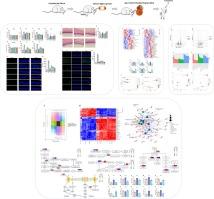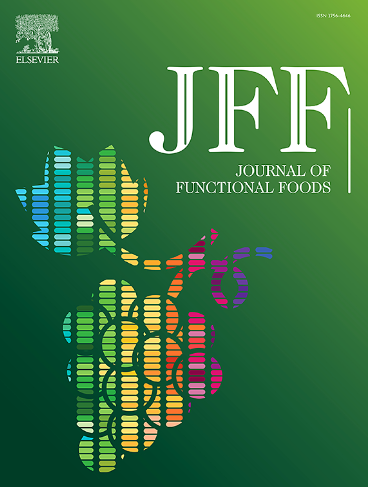Integrated analysis of transcriptomics and metabolomics reveals the mechanisms underlying green tea intervention in age-related macular degeneration
IF 3.8
2区 农林科学
Q2 FOOD SCIENCE & TECHNOLOGY
引用次数: 0
Abstract
Age-related macular degeneration (AMD) is a degenerative disease that severely impairs vision, often accompanied by oxidative stress damage, cellular apoptosis, and inflammatory responses in the retina. Green tea, which is rich in polyphenols, typically exhibits strong antioxidant, anti-apoptotic, and anti-inflammatory properties. In this study, an AMD rat model was induced through a combination of intense light exposure and intraperitoneal injection of sodium iodate. An integrated systems biology approach, combining metabolomics and transcriptomics analysis, was employed to investigate the pharmacological basis of green tea extract (GTE) intervention, elucidate key mechanisms of action, and screen for potential biomarkers. The results indicated that GTE significantly improved oxidative stress damage and inflammatory responses in the retina of AMD rats. Additionally, GTE inhibited retinal cell apoptosis by regulating the expression of caspase-3 protein. Integrated metabolomics and transcriptomics analyses revealed that GTE activates Glycerophospholipid metabolism, Ether lipid metabolism, Retinol metabolism, Arachidonic acid metabolism, and Vascular smooth muscle contraction signaling pathways in the retina of AMD rats. This activation was achieved through the modulation of gene expressions such as Pla2g3, Mboat1, and Awat2, influencing the levels of retinol, prostaglandin F2α, and multiple phospholipid metabolites in the retina. qRT-PCR experiments confirmed that GTE can regulate the expression levels of several key genes involved in inflammatory responses, phospholipid metabolism, and retinol metabolism, thereby enhancing its therapeutic activity against AMD. In summary, these findings confirm the substantial therapeutic potential of green tea in the treatment of AMD, providing a foundation for clinical applications and drug development.

转录组学和代谢组学的综合分析揭示了绿茶干预老年性黄斑变性的机制
老年性黄斑变性(AMD)是一种严重损害视力的退行性疾病,通常伴有氧化应激损伤、细胞凋亡和视网膜炎症反应。绿茶富含茶多酚,通常具有很强的抗氧化、抗细胞凋亡和抗炎特性。在这项研究中,通过强光照射和腹腔注射碘酸钠相结合的方法诱导了一种老年性视网膜病变大鼠模型。该研究采用了一种综合的系统生物学方法,结合代谢组学和转录组学分析,研究绿茶提取物(GTE)干预的药理学基础,阐明其关键的作用机制,并筛选潜在的生物标志物。结果表明,绿茶提取物能明显改善 AMD 大鼠视网膜的氧化应激损伤和炎症反应。此外,GTE 还能通过调节 Caspase-3 蛋白的表达抑制视网膜细胞凋亡。综合代谢组学和转录组学分析表明,GTE 可激活 AMD 大鼠视网膜中的甘油磷脂代谢、醚脂代谢、视黄醇代谢、花生四烯酸代谢和血管平滑肌收缩信号通路。这种激活是通过调节 Pla2g3、Mboat1 和 Awat2 等基因的表达,影响视黄醇、前列腺素 F2α 和视网膜中多种磷脂代谢物的水平来实现的。qRT-PCR 实验证实,GTE 可以调节炎症反应、磷脂代谢和视黄醇代谢中几个关键基因的表达水平,从而增强其对 AMD 的治疗活性。总之,这些发现证实了绿茶在治疗老年性视网膜病变方面的巨大治疗潜力,为临床应用和药物开发奠定了基础。
本文章由计算机程序翻译,如有差异,请以英文原文为准。
求助全文
约1分钟内获得全文
求助全文
来源期刊

Journal of Functional Foods
FOOD SCIENCE & TECHNOLOGY-
CiteScore
9.60
自引率
1.80%
发文量
428
审稿时长
76 days
期刊介绍:
Journal of Functional Foods continues with the same aims and scope, editorial team, submission system and rigorous peer review. We give authors the possibility to publish their top-quality papers in a well-established leading journal in the food and nutrition fields. The Journal will keep its rigorous criteria to screen high impact research addressing relevant scientific topics and performed by sound methodologies.
The Journal of Functional Foods aims to bring together the results of fundamental and applied research into healthy foods and biologically active food ingredients.
The Journal is centered in the specific area at the boundaries among food technology, nutrition and health welcoming papers having a good interdisciplinary approach. The Journal will cover the fields of plant bioactives; dietary fibre, probiotics; functional lipids; bioactive peptides; vitamins, minerals and botanicals and other dietary supplements. Nutritional and technological aspects related to the development of functional foods and beverages are of core interest to the journal. Experimental works dealing with food digestion, bioavailability of food bioactives and on the mechanisms by which foods and their components are able to modulate physiological parameters connected with disease prevention are of particular interest as well as those dealing with personalized nutrition and nutritional needs in pathological subjects.
 求助内容:
求助内容: 应助结果提醒方式:
应助结果提醒方式:


